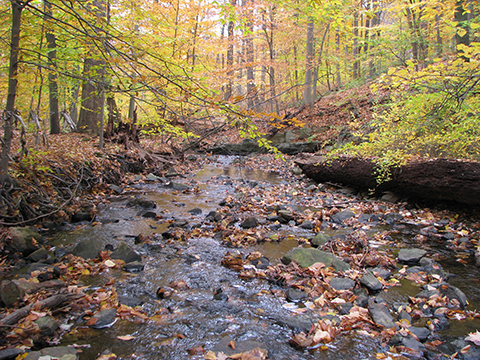By Dan Ross
As the air grows brisk, and the days get shorter, there’s no better time to get outside and immerse yourself in nature! The sights and sounds of autumn are all around us; from the changing colors of the tree canopy to the noticeable scurry of woodland animals preparing for the long harsh months ahead. Yet amidst the hustle and bustle of nature, something seems to be missing, or gone awry, as if nature has moved on without us.
All too often the iconic scenes of children playing in leaf piles, or climbing to the top branches for the biggest juiciest apple, have disappeared from the landscape. Trails go unexplored, forts go unassembled, bugs are left to their own devices. Rocks and logs remain in place, sheltering newts and salamanders from prying eyes, and streams gurgle along undisturbed. No, there hasn’t been a tragic shortage of children in the world, but rather a disconnect between their attention spans and the fascination and wonderful excitement that only nature can offer.
The term “nature deficit disorder” was first coined by Richard Louv, author of “Last Child in the Woods,” and it alludes to the fact that people, most notably children, are spending far less time outdoors, which he believes has resulted in a wide range of behavioral problems. Children are growing into young adults with asthma, allergies, and a complete disregard for the outdoors. In some small way, the magic and excitement of nature has been extinguished.
While these correlations have not been accepted by the medical and mental health fields, and you won’t find the phrase in any clinical mental health manuals, at least anecdotally, I think we can all recall fond memories of childhood playing outdoors and embracing nature and feeling more in touch with the changing of the seasons.
In fact, according to the latest polls, Americans spend nearly 90% of their time indoors, and on average about an hour or more, each day, staring mindlessly at our cellular devices. When children do venture outside, it is often as they are on their way to sports practice, or another form of structured activity, and far less likely to be exploring the wood or streams.
Without even considering the obvious negative impacts this likely has had on our health, this complete disconnection with the outside world has created a sense of apathy and disinterest in our environment and the plants and animals that call this planet home. Sure there are now phone apps which are aimed at increasing physical activity outdoors, such as a very popular game where the goal is to “catch ‘em all”. But this still falls tragically short of actually getting kids outdoors once again, exploring and staying out until the streetlights come on.
Undeniably times have changed, and technology isn’t going anywhere anytime soon, but perhaps it’s truly critical now, more than ever, to rediscover nature and all of its wonders before they are lost to an indifferent generation.
At GSWA, we are dedicated to educating the public on water quality issues, intelligent land use decisions, and threats to the health and well-being of the environment. We have expanded our education and outreach department to include even more outdoor educational programing, hikes, and opportunities to get out and reconnect with nature. We urge you to join us in celebrating nature and discovering the power of the great outdoors, the videogames can wait! For information on upcoming hikes and events, check us out at www.greatswamp.org
